This is the story of Lynch’s Bridge over the Maribyrnong River in Melbourne’s west, connecting Smithfield Road in Flemington to Ballarat Road in Footscray.
On the downstream side is the original 1936 bridge, with art deco-styled decorative parapets, pillars, and light fittings.
And beside it a far more utilitarian concrete bridge completed in 1992.
In the beginning
Lynch’s Bridge was an early crossing place on the Maribyrnong River for those headed west of Melbourne, with owner of the neighbouring Pioneer Hotel, Michael Lynch, operating a punt on the site from 1849. A competing crossing was operated by Joseph Raleigh at Maribyrnong, which replaced his punt with a bridge in 1858.
And so in 1863 Michael Lynch petitioned the government for permission to replace his punt with a pontoon bridge, provided he was granted a half acre of land on the eastern bank of the river for the abutments and approaches.
Members of the Essendon and Flemington Council not in favour of private bridges, and the matter was debated, with one local resident questioning the motives of Lynch.
In September 1864 a motion was passed to prohibit Lynch from building a bridge, but it soon rescinded, with the new bridge in use for Melbourne Cup Day 1864.
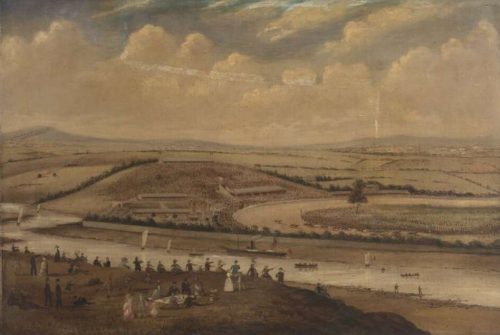
‘Flemington Racecourse from the Footscray side of Salt Water River, Victoria ‘ by J Ryan
Local residents found the toll gate a nuisance, but Lynch talked up his bridge, telling Western District sheep and cattle owners they only needed to pay a single toll if headed to the sheep and cattle yards on the opposite bank.
As a result in 1866 the Essendon and Flemington Council proposed purchasing Mr Lynch’s bridge, as did the Footscray Council in 1867. However it took until in 1882 for the bridge to be brought under public ownership, the Footscray Council abolished the toll and requesting the Commissioner of Public Works pay the reminder of the loan.
A replacement bridge
However that was not the end of the saga – in October 1901 Lynch’s Bridge was closed by the Public Works Department due to it falling into disrepair, and a Mr J. Byers erected a pontoon bridge beside it to carry traffic to Flemington Racecourse, for a “small toll” of one penny. The debate as to who should fund the cost of a new bridge continued in the months that followed, with a tender finally awarded in December 1902 – eighteen months since the bridge was closed.
The new bridge opened without ceremony in May 1903, after contractors finished their work and left it open for traffic, with members of the Flemington and Kensington Council holding an official opening a few days later, without the involvement of the Footscray Council who also funded it.
The new bridge was built of timber, and had a lifting span in the middle, which sometimes caused delays to river traffic, and had high ongoing running costs.
Haven’t we been here before?
September 1929 was a familiar event – Lynch’s Bridge closed after being declared unsafe for traffic, reopening after temporary repairs were completed over a three week period.
The Footscray Council and the City of Melbourne then considered a number of options for a permanent crossing – a new five span reinforced concrete bridge for £38,750, a new three span steel bridge for £35,900, or extending the life for the existing bridge for five years for £2,250. The Footscray Council objected having to fund half the cost of a new bridge, delaying the start of construction, with an agreement finally reached in January 1936 for the Country Roads Board to pay half the cost of the project.
Opened in 1939, the new Lynch’s Bridge was built on a different angle to the timber bridge it replaced, allowing Ballarat Road to be realigned to meet Smithfield Road, eliminating a dangerous curve on the Footscray side. The Footscray Council suggested naming the new bridge ‘Gent’s Bridge’ after the Town Clerk of Footscray, but it came to nothing.
Traffic troubles
As Melbourne grew, the amount of traffic using Lynch’s Bridge grew – 43,000 vehicles per day using it in 1989, half the volume that used the West Gate Bridge. And the area became known as a blackspot for motor vehicle crashes, with the 1985-88 period seeing 79 separate incidents, including 16 head-on collisions, and nine deaths.
Leading in November 1989 to a coronial inquest being opened into a number of recent fatalities at the site.
Excessive speed was the main cause of car accidents on Lynch’s Bridge in Kensington, an inquest on three deaths on the bridge was told yesterday.
Sergeant Noel Osborne, of the accident Investigation section at Brunswick, said that despite measures to make the four-lane bridge safer, most vehicles approached it too fast.
The deputy state coroner, Mr Graeme Johnstone, is holding joint inquests on Kevin John Lewis, 35, of Broadmeadows, and Emily Jane Stonehouse, 4, of Werribee, who were killed in an accident on 23 October 1988, and Matthew James Simmons, 25, of Box Hill, who died in an accident on 14 February this year.
Lynch’s Bridge crosses the Maribyrnong River near Flemington Racecourse. The approach from Footscray, on Ballarat Road, has three lanes that narrow to two before a sharp left-hand bend on to the bridge. The Smithfield Road approach, from Flemington, is two lanes.
Sergeant Osborne, asked by Mr Johnstone to suggest safety measures, said that even if the Ballarat Road approach was narrowed to one lane in an effort to slow traffic, he believed many drivers would still try to take the bend too fast. He said the answer was to duplicate the bridge.
“That in my mind is the answer. We certainly would not be having the head-ons as we are now. The number of people killed at this location has caused me great concern. It appears that not a great deal has been done.”
Mr John Connell, of the Roads Corporation, said speed cameras had shown that more than 70 per cent of vehicles approaching the bridge on Ballarat Road travelled faster than the 60 kmh speed limit. The fastest speed had been 139 kmh despite signs recommending 55 kmh.
Peter James McDonald, a truck driver from Maidstone who crosses Lynch’s Bridge regularly, said that at the time of the accident involving Mr Simmons, the camber of the road pulled vehicles to the right as they turned left on to the bridge from Ballarat Road. The inquiry is continuing
The inquest heard that duplication of the bridge had been proposed in 1975, with the cost in 1989 money estimated to be $3 million.
In his findings to the 1989 inquest, Coroner Graeme Johnstone noted that the 1938 bridge was not unsuitable for the volume and speed of traffic passing over it, recommending that the Ballarat Road approach to the bridge be restructured so that the three-to-two lane merge is further from the sharp bend onto the bridge, and that the VicRoads make duplication of the bridge a priority in their road improvement program.
As a result, a duplicate bridge on the upstream side of original bridge was completed in 1992, allowing the 1936 bridge to be dedicated to westbound traffic.
The duplication of Lynch’s Bridge and road approaches at Flemington was opened to traffic in April 1992 and has eliminated one of Melbourne’s worst accident blackspots. In accordance with a Coronial Inquiry recommendation to fast track the works, new technology for bridgeworks and roadworks construction was used. Road approaches over poor ground conditions utilised polystyrene as lightweight fill – a first for VicRoads and Australia. The method reduces road settlements to manageable levels and achieves cost savings over more conventional alternatives. The project was completed in June 1992 at a cost of $5.5million.
And finally – another upgrade
In August 2019 it was announced that Lynch’s Bridge would be upgraded as part of the Western Road Upgrade public–private partnership.
A National Trust-listed bridge which was once the main gateway to Melbourne’s west will be upgraded this week as part of the Victorian Government’s Suburban Roads Upgrade.
Member for Footscray Katie Hall today announced the start of important work to rehabilitate the Ballarat Road Bridge, under the $1.8 billion Western Roads Upgrade.
The crossings over the Maribyrnong River are steeped in history, with the outbound Lynch’s Bridge built in 1936 and heritage listed for its “historical and technical significance” by the National Trust in 2005. Millions of Victorians and visitors would have crossed this bridge in some form.
Lynch’s Bridge also holds technical engineering significance, as one of the first steel and concrete crossings designed so the reinforced concrete deck works together with the steel beams.
The historic five-span bridge sits alongside its more modern counterpart known as the Smithfield Bridge, which was built in 1990.
The 108-metre bridges will undergo work to strengthen them for the future for up to 45,000 vehicles which travel over them every day.
It is anticipated they’ll be used by up to 50,000 cars and trucks daily by 2031.
The art-deco style of Lynch’s Bridge will be preserved as safety barriers are upgraded on both bridges, and footpaths and drainage will also be improved.
There will be some lane closures in place as this work is underway to ensure road crews can work safely and quickly.
– removed old barriers and replaced them with new safety barriers
– installed cathodic corrosion protection to protect the metal bridge supports from rust and deterioration
– resurfaced the road on the bridges and on approach to the bridges
– removed features no longer needed such as broken lights.
You had to look close to see the changes.
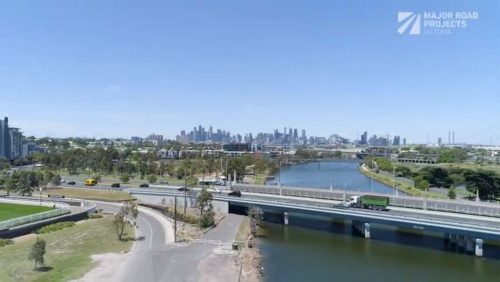
Major Roads Project Victoria photo
But the big new crash barriers are easy to see when driving past.
But one thing that is obvious is the focus on motor vehicles, not active transport.
The bridge has enough space for a grass median strip!
Yet pedestrians are forced into a narrow footpath.
And cyclists are given a narrow strip of asphalt, centimetres from passing vehicles.
Pretty crap upgrade, isn’t it?
Footnote: water under the bridge
When I visited Lynch’s Bridge in December 2020, I noticed these new looking steel additions to the piers of the 1992 bridge.
My initial thought was strengthening work linked to the Western Road Upgrade project, but turns out I was wrong – it’s actually linked to the West Gate “Tunnel” Project.
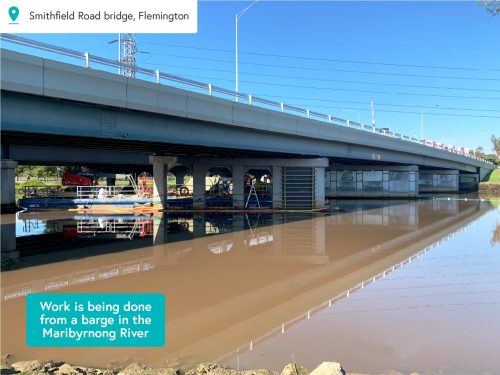
West Gate Tunnel Project photo
A post on their Facebook page dated 11 November 2021 mentioning the work.
🚧 West Gate Tunnel Project crews have started working on modifications to streamline the piers on the Smithfield Road Bridge.
⛴️ These works will help during high flows in Maribyrnong River and mitigate flooding once our new Maribyrnong River bridge is built. Gaps between the columns will be filled with concrete to create a wall type pier with rounding at both ends.
The works required to compensate for new piers in the Maribyrnong River at Footscray.
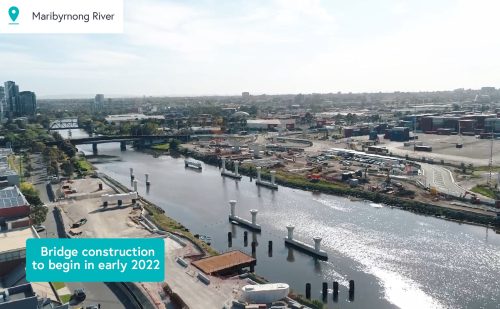
West Gate Tunnel Project photo
Forming part of the elevated roadway between Footscray Road and the actual West Gate “Tunnel”.
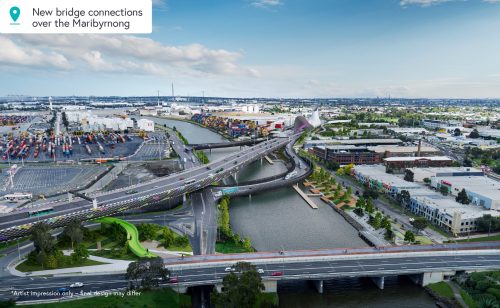
West Gate Tunnel Project photo
And the work at Lynch’s Bridge seems to have flown under the radar – the only other mention of it I could find was a single line in the West Gate Tunnel Project “Final Report for Submission to the Minister for Planning” for March 2019 to August 2019.
Flood mitigation works completed at Smithfield Bridge
I wonder what difference these works made to the October 2022 Maribyrnong River flood?
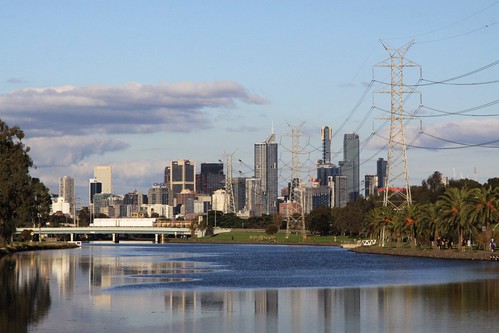
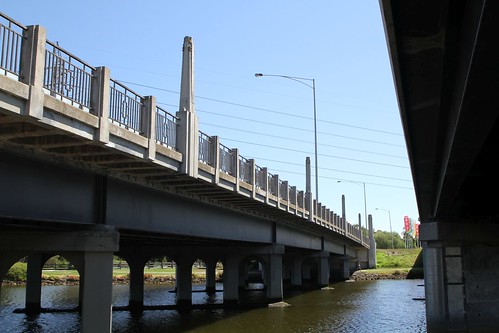
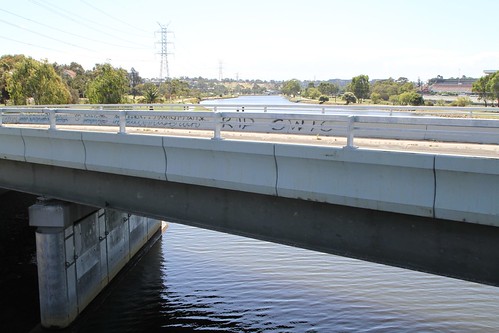
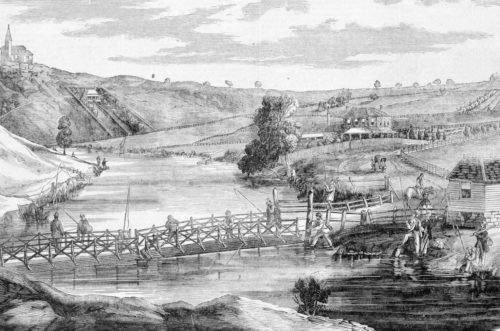
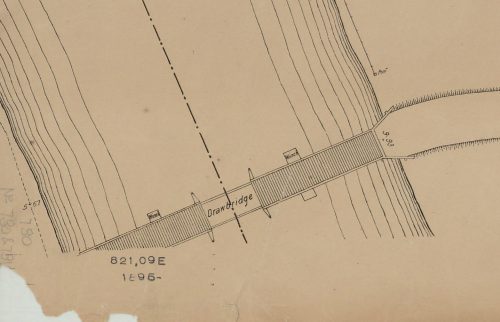
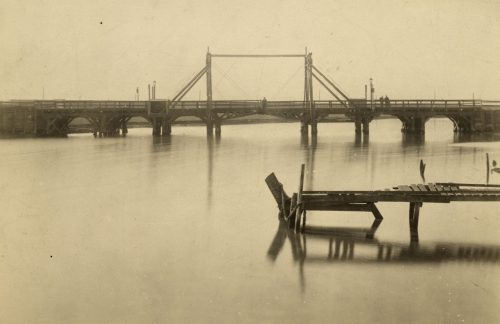
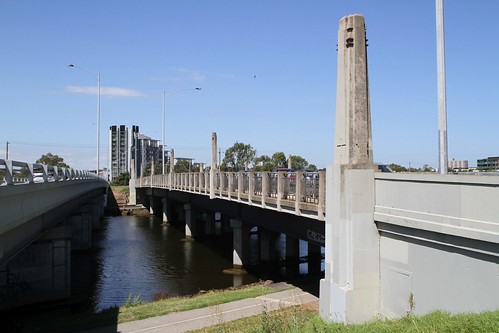
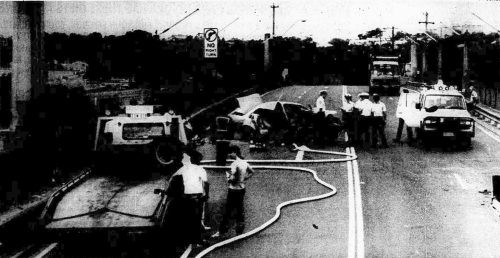
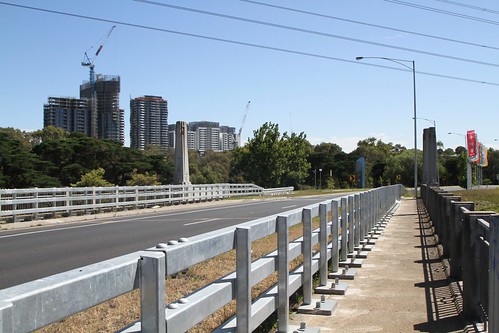
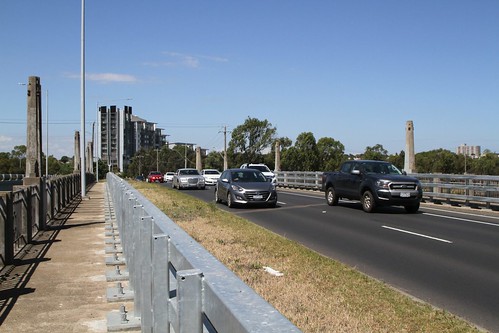
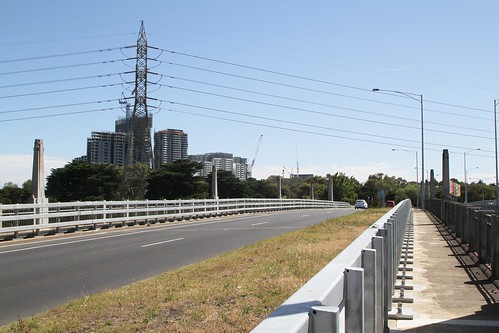
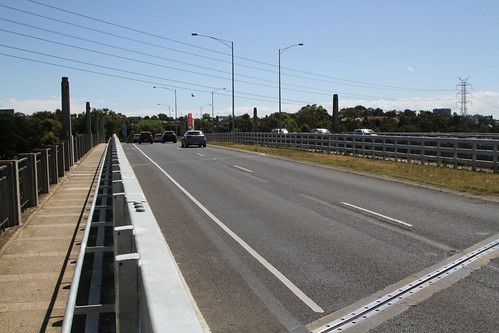
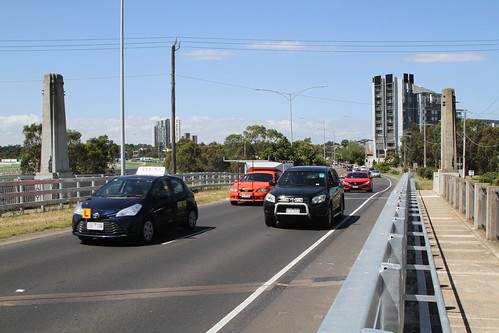
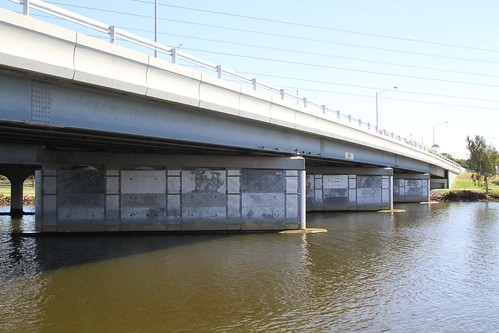

Thank you for this article, Marcus.
I have a twofold interest in this bridge.
1. In 1973 a classmate of mine from school in Warragul in the 1960s was killed in a motorbike accident “as the result of a collision with a guard rail on a bridge at Flemington”. I have always assumed it was this bridge.
2 My son and his family live in the nearby Lynch Street in Footscray and I presume this street is also named after Michael Lynch.
I enjoy reading your articles.
Leo
Hey Leo,
Glad you enjoyed my work!